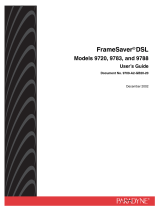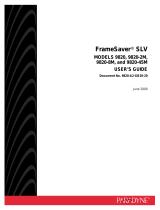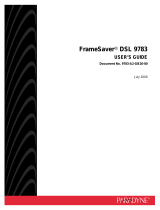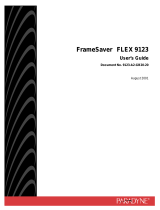Page is loading ...

Article ID: 1450
Q&A
Management Options for ADTRAN IQ Products
Q:
Management Options for ADTRAN IQ Products
A:
Introduction
This document contains examples of typical IP addressing schemes used with ADTRAN
IQ™ products. Listed below are general items to consider when choosing the IP
addressing scheme for your network. Also included is how to configure the IQ units to
send traps to a Network Management Station (NMS).
Note: All subnet masks used in the examples are assumed to 255.255.255.0
Out-of-Band Management
An optional 10Base T LAN card (P/N 1204005L1) is available for the DSU IQ, TSU IQ, &
TSU IQ+ products. The IQ Probe has a built-in 10Base T port. The NxIQ product has the
capability to utilize the built-in 10Base T port of a TSU XX0e series multiplexer. A
discussion of this management method is below.
LAN Port Addressing Option
All of the IQ units in this type of network have the ESP 10Base T LAN card option. This
allows the IQ units to have local LAN IP addresses.
Considerations:
•
Can use dynamic routing to resolve IP path to remote site IQ units
•
Utilizes IP address of local LAN for each site
•
Can access remote site IQ unit from remote site LAN host
•
Can use any type of Frame Relay encapsulation

Inband Management
The Inband Management feature of the ADTRAN IQ products allow the units to
recognize IP datagrams addressed to the unit that are inband with customer data. Data
Link Connection Identifier (DLCIs) can be configured in the unit so that they are
monitored for the IP address configured on the IQ unit. For this option to work, the
Frame Relay frames on the PVC monitored by the IQ unit must be encapsulated using
RFC 1490/2427 (an industry standard) and the IP datagrams addressed to the IQ unit
must be uncompressed. This feature allows for a number of advantages and flexibility in
determining the management strategy, as described below.
It is important to note that the IQ units are capable of inband management both on the
DTE port and the network port but the nature of their operation is different. The network
port simply monitors PVCs (DLCIs) that are purchased from the Frame Relay carrier.
The DTE port creates a separate PVC (default is 1007) for management. This PVC
exists between the DTE port of the IQ and the router (DTE device) only. Therefore, it will
appear to the router that an additional PVC is available (DLCI 1007) that has not been
purchased from the Frame Relay carrier. This PVC is for management of this IQ unit
only. No other data traffic (i.e., routing protocol updates, etc.) should be routed to this
PVC.
Inband WAN Addressing Option
In an inband WAN-addressed network, the IQ units and the router serial ports all have
WAN IP addresses.
Considerations:
•
Additional router configuration required to access remote site IQ units
•
Utilizes the same subnet for both the IQ units and the router serial ports
•
Can access remote site IQ unit from remote site LAN host
•
Requires RFC 1490/2427 Frame Relay encapsulation
Inband LAN Addressing Option
In an inband LAN-addressed network, the host site IQ unit has a WAN IP address, while
the remote site IQ units each have a local LAN IP address.
Considerations:
•
Can use dynamic routing to resolve IP path to remote site IQ units
•
Utilizes separate subnet for the host site IQ unit only
•
Cannot access remote site IQ unit from a remote site LAN host
•
Requires RFC 1490/2427 Frame Relay encapsulation
Inband Subinterface Addressing Option
In an inband subinterface addressed network, the serial ports of the routers are
subinterfaced. Each router port has a subinterface per PVC as well as a separate

subnet.
Considerations:
•
No additional router configuration required to access remote site IQ units if using routing
protocol that passes subnet mask information (i.e., OSPF, RIP2, etc.)
•
Uses one additional subnet for local management traffic at the each site
•
Can access remote site IQ unit from remote site LAN host
•
Requires RFC 1490/2427 Frame Relay encapsulation only on DTE management PVCs
(Default 1007)
Inband Hybrid Subinterface WAN Addressing Option
In an inband hybrid subinterface WAN-addressed network, the serial port of the host site
router is subinterfaced. Each PVC at the host site router port has its own subinterface as
well as its own subnet. The remote site routers are not subinterfaced.
Considerations:
•
Additional router configuration required to access remote site IQ units
•
Uses one additional subnet for local management traffic at the host site
•
Can access remote site IQ unit from remote site LAN host
•
Requires RFC 1490/2427 Frame Relay encapsulation only on DTE management PVC
(Default 1007)
Traps
There are three fields in the IQ units which need to be configured to enable traps: Trap
DLCI, Trap IP, and Trap Port. The Trap DLCI identifies the DLCI on which the trap
needs to be sent to reach the Network Management Station (NMS). The Trap IP is the
IP of the NMS. The Trap Port is the port through which the trap needs to be sent to
reach the NMS. If the NMS is reached via the Frame Relay network, then the Trap Port
will be the network port. If the NMS is on the same network as the IQ unit, then the Trap
Port will be the port which contains the management traffic (Ethernet if a LAN card is
installed, otherwise, DTE port.)
Summary
The examples included below are intended to demonstrate the configuration necessary
on the IQ units based on the addressing scheme selected. Other variations of these
examples can be utilized based on individual requirements. For example, the inband
WAN addressing method may be chosen for use with the remote site units, but an
Ethernet option card can be utilized in the host site unit.

FIGURE 1
IQ Configurations for Figure 1
Host Site IQ
Remote Site IQ #1
Remote Site IQ
#2
DTE Port:
Management DLCI: 1007 (default) 1007 (default) 1007 (default)
Management Option:
Disabled Disabled Disabled
Network Port:
Management DLCI 1:
1006 (default) 1006 (default) 1006 (default)
Management DLCI 2:
1005 (default) 1005 (default) 1005 (default)
Mgmt DLCI 1 Mode:
Shared (default)
Shared (default) Shared (default)
Mgmt DLCI 2 Mode:
Shared (default)
Shared (default) Shared (default)
System:
IP Address: 10.1.1.2 10.2.1.2 10.3.1.2
Trap DLCI: 0 0 0
Trap IP: 10.1.1.3 10.1.1.3 10.1.1.3
Trap Port: Ethernet Port Ethernet Port Ethernet Port

FIGURE 2
IQ Configurations for Figure 2
Host Site IQ
Remote Site IQ #1
Remote Site IQ
#2
DTE Port:
Management DLCI: 1007 (default) 1007 (default) 1007 (default)
Management Option:
Enabled (default)
Enabled (default) Enabled (default)
Network Port:
Management DLCI 1:
1006 (default) 16 16
Management DLCI 2:
1005 (default) 1005 (default) 1005 (default)
Mgmt DLCI 1 Mode:
Shared (default) Shared (default) Shared (default)
Mgmt DLCI 2 Mode:
Shared (default) Shared (default) Shared (default)
System:
IP Address: 10.1.2.4 10.1.2.5 10.1.2.6
Trap DLCI: 1007 16 16
Trap IP: 10.1.1.3 10.1.1.3 10.1.1.3
Trap Port: DTE Port Network Port Network Port

FIGURE 3
IQ Configurations for Figure 3
Host Site IQ
Remote Site IQ #1
Remote Site IQ
#2
DTE Port:
Management DLCI: 1007 (default) 1007 (default) 1007 (default)
Management Option:
Enabled (default)
Disabled Disabled
Network Port:
Management DLCI 1:
1006 (default) 16 16
Management DLCI 2:
1005 (default) 1005 (default) 1005 (default)
Mgmt DLCI 1 Mode:
Shared (default) Shared (default) Shared (default)
Mgmt DLCI 2 Mode:
Shared (default) Shared (default) Shared (default)
System:
IP Address: 10.1.2.4 10.2.1.2 10.3.1.2
Trap DLCI: 1007 16 16
Trap IP: 10.1.1.3 10.1.1.3 10.1.1.3
Trap Port: DTE Port Network Port Network Port

FIGURE 4
IQ Configurations for Figure 4
Host Site IQ
Remote Site IQ #1
Remote Site IQ
#2
DTE Port:
Management DLCI: 1007 (default) 1007 (default) 1007 (default)
Management Option:
Enabled (default)
Enabled (default) Enabled (default)
Network Port:
Management DLCI 1:
1006 (default) 1006 (default) 1006 (default)
Management DLCI 2:
1005 (default) 1005 (default) 1005 (default)
Mgmt DLCI 1 Mode:
Shared (default) Shared (default) Shared (default)
Mgmt DLCI 2 Mode:
Shared (default) Shared (default) Shared (default)
System:
IP Address: 10.1.4.2 10.1.5.2 10.1.6.2
Trap DLCI: 1007 1007 1007
Trap IP: 10.1.1.3 10.1.1.3 10.1.1.3
Trap Port: DTE Port DTE Port DTE Port

FIGURE 5
IQ Configurations for Figure 5
Host Site IQ
Remote Site IQ #1
Remote Site IQ
#2
DTE Port:
Management DLCI: 1007 (default) 1007 (default) 1007 (default)
Management Option:
Enabled (default)
Enabled (default) Enabled (default)
Network Port:
Management DLCI 1:
1006 (default) 16 16
Management DLCI 2:
1005 (default) 1005 (default) 1005 (default)
Mgmt DLCI 1 Mode:
Shared (default) Shared (default) Shared (default)
Mgmt DLCI 2 Mode:
Shared (default) Shared (default) Shared (default)
System:
IP Address: 10.1.4.2 10.1.2.3 10.1.3.3
Trap DLCI: 1007 16 16
Trap IP: 10.1.1.3 10.1.1.3 10.1.1.3
Trap Port: DTE Port Network Port Network Port
/







